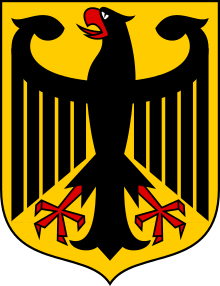Agriculture in Germany
Agriculture in Germany represents only a minor sector of the national economy as the number of employees has rapidly declined since the 19th century Industrialisation period[1][2] and again, drastically during the 20th century. By 1989 agriculture amounted to only 1.6 percent of the West German GDP. Although the percentage of the agricultural sector of the East German GDP was twice as high, its total proportion of the reunited Germany's GDP amounted to only about two percent. Despite the sector's relatively small work force, that continues to decline in the 21st century and the mere 0.9 percent value share in the national GDP (2007), its use of more than half of the country's surface area, its impact on the environment and its fundamental connection to health issues, makes it politically very important.[3] As one of the four largest producers in the European Union, large scale outdoor vegetable cultivation, such as potatoes and cereals accounts for the highest output.[4][5]
History
The number of farms had decreased steadily in West Germany, from 1.6 million in 1950 to 630,000 in 1990. In East Germany, where farms were collectivized under the socialist regime in the 1960s, there had been about 5,100 agricultural production collectives with an average of 4,100 hectares under cultivation. Since unification, about three-quarters of the collectives have remained as cooperatives, partnerships, or joint-stock companies. Other East German collectives were broken up, ownership reverting primarily the individual farmers who had been accorded post-war title to their lands; or were privately sold, becoming about 14,000 private farms. The terms of the 1990 Unification Treaty precluded former agricultural land owners - expropriated by the Soviet Occupation authorities - from reclaiming their vast pre-war agricultural estates. In western Germany and in the newly privatized farms in eastern Germany, family farms predominate. For the 630,000 farms, there are 750,000 full-time employees. There are also, however, many more part-time employees, and most farms do not represent their owners' full-time occupation.
Although the number of farms has declined, production has actually increased through more efficient production methods. By the early 1990, a single farmer could produce enough food for seventy-five people, far more than was the case in the 1950s or 1960s.
Production
Agricultural products vary from region to region. In the flat terrain of northern Germany and especially in the eastern portions, cereals and sugar beets are grown. Elsewhere, with the terrain more hilly and even mountainous, farmers produce vegetables, milk, pork, or beef. Almost all large cities are surrounded by fruit orchards and vegetable farms. Most river valleys in southern and western Germany, especially along the Rhine and the Main, have vineyards. Beer is produced mainly, but not exclusively, in Bavaria. Wine is produced mainly, but not exclusively, in Rhineland-Palatinate.
German agriculture and EU
Since the 1960s, German agricultural policy has not been made in Germany but in the EC. All agricultural laws and regulations are written in Brussels, often after difficult negotiations between food-producing and food-consuming states. The main objective of those negotiations is to obtain high incomes for the farmers while keeping market prices low enough to avoid consumer protests. To make up the difference, the EC adopted the Common Agricultural Policy (CAP—see Glossary) subsidy program and the export subsidy program, both of which benefit German farmers as well as other EU farmers. In return, the German farmers have complied with European directives on the quality and quantity of production.
References
- Perkins, J.A. (Spring 1981). "The Agricultural Revolution in Germany 1850–1914". Journal of European Economic History. 10 (1): 71–119.
- Leslie Page Moch. "Internal migration before and during the Industrial Revolution: the case of France and Germany". EGO. Retrieved April 4, 2019.
- "German Agriculture - Facts and Figures" (PDF). Federal Ministry of Food, Agriculture and Consumer Protection. Retrieved April 23, 2019.
- "GERMANY". Food and Agriculture Organization of the United Nations. Retrieved April 23, 2019.
- "Environment and agriculture – Overview for Germany". Umweltbundesamt. June 7, 2018. Retrieved April 23, 2019.
External links
- Thomas, Frieder; Schmidt, Götz (2006). Förderung von Existenzgründungen in der Landwirtschaft: ein Projekt im Auftrag des BMELV (03HS016): Projektbericht. Münster-Hiltrup: Landwirtschaftsverlag. ISBN 3-7843-0513-X.
![]()
